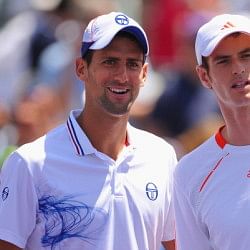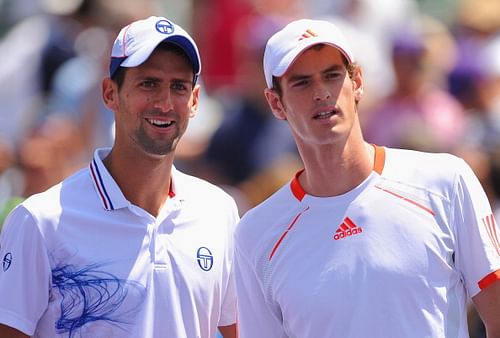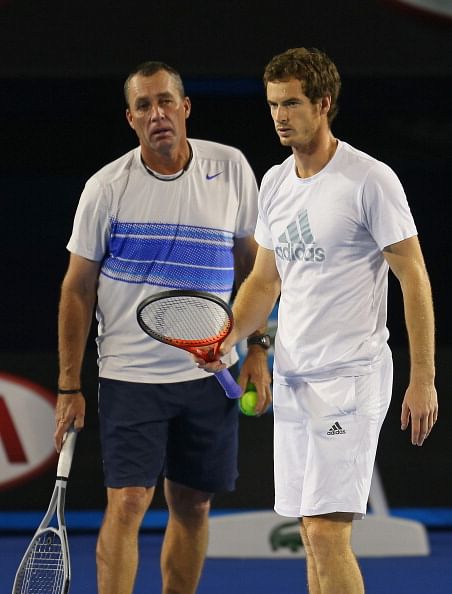
Without Ivan Lendl's support, Andy Murray has a task on his hands to catch up with Novak Djokovic

Novak Djokovic and Andy Murray – similar players in some respects, but also very dissimilar in others
There are a lot of professional similarities between Novak Djokovic and Andy Murray. Just as there are a lot of differences too. But unlike many other rivals, where similarities and differences form a parallel line of existence, the differences between Djokovic and Murray emerge and take shape from where their similarities end, effectively polarising them completely.
To start with, their game, which at first glance looks to be the biggest similarity between the two, is in fact the biggest point of differentiation between them. Djokovic’s and Murray’s styles of play may seem near-identical, consisting basically of punishing groundstrokes from the baseline, but it is the way that each of them manages to harness this style of play to meet the criticality of the situation that indelibly separates the former from the latter, emphasising his mettle even more prominently.
For Novak Djokovic, the aspect of doing well under pressure comes quite naturally. He doesn’t get bogged down by internal conflicts, and even if he is in a troubled frame of mind, he does well to hide that from the opponent’s eyes. More often than not, it’s these tense situations that tend to break the opponent’s concentration; when his back is against the wall, the Serb drives his onslaught even more lethally, as if to display one last remnant of audacity.
This aspect of Djokovic has a lot more to do with his inherently strong self-belief and mental fortitude than him trying to physically overawe his opponent into conceding defeat. And the Serb has managed to refine these qualities further in the past few years, in a fitting cape to surround his ascension at the top of the tennis order. He may start the match slow, be overly defensive for most of the match, but when the proverbial push comes to shove, Djokovic’s self-belief comes to the fore, and his psychological fortitude helps him to channel his game with greater effectiveness.
It is when juxtaposed with this facet of Djokovic that Murray falls short. His talent has never been in question, and there’s no doubt that he has the game to be competitive on the biggest of the sport’s stages. But as gifted as Murray is, his skills get invariably marred when he’s facing the heat from the opponent.
‘Meltdown’ doesn’t even come close to describing Murray’s state as you watch him descend into a long monologue when cornered, venting his frustration verbally and through agitated hand gestures, rather than come up with a last-resort defiant fightback.
In the initial years when Murray made it into the finals of Majors, his frequent emotional upheavals and corresponding unravelling of his performance could have been attributed to him getting overwhelmed by the occasion. Even Djokovic wasn’t an exception to this feeling of overwhelming stupor during the early years of his forays into the last round of Majors.
But the divergence between both players despite their beginners’ similarities is that Djokovic eventually gained the poise and self-confidence to claim a stake as a tournament favourite alongside the other expected favourites. On the other hand, the repetition of the same old patterns for Murray despite the progression of years and his steady presence in the ultimate stages of Majors meant that the Scot – by his own hands – was confined to remain a finalist and not come out as a winner, however deserving he may have been otherwise throughout the course of the event.

Without Ivan Lendl’s support, Andy Murray has a struggle on his hands
The presence of Ivan Lendl was thus quite instrumental to Murray’s growth as a player. It is said that after a certain point coaches can’t really do much for a player’s game, except to tweak it slightly, giving it underlying nuances here and there. But the transformation that Lendl brought about as Murray’s coach went far deeper than a slight fine-tuning of his charge’s shot-making.
It wasn’t so much Murray’s game as it was his attitude that Lendl focused upon. The solidity of his game remained as intact as it was previously, if not more, but the vexed ramblings midway during the course of the match reduced substantially. There was more calmness, better composure and most of all, there was more assuredness in the way Murray dealt with nerves during tension-riddled moments in his matches.
Murray’s wins at the 2012 US Open and the 2013 Wimbledon Championships were perhaps the least surprising events that transpired in the two tennis seasons that he and Lendl worked together. Rather, these actualities, by virtue of their delay, added more emphasis to the whole ‘Murray coming of age’ angle. These two victories also ensured that the divergences between Djokovic and Murray on this particular aspect were paused with a certain degree of vehemence.
But following the unexpected halt to Lendl’s and Murray’s unorthodoxly intuitive professional partnership, the same set of differences between the two players stands to crop up again – have already started to crop up, in fact. Djokovic still continues to loom as dangerous as ever in spite of his upset losses at the start of the season while Murray, troubled as he is with injury-related issues, looks to have fallen back on his old ways of being a battle-scarred soliloquist.
Will Murray be motivated by his achievements and cull down the negativity, taking full control of the future course of his professional journey? The gamut of similarities and dissimilarities between Djokovic and Murray is perhaps at its most malleable juncture right now, and it may well be moulded one way or the other depending on how Murray goes about his business.
The key, as the cliche goes, lies in whether Murray can defend all that he has achieved in the last two years without the physical presence and support of his coaching mentor.